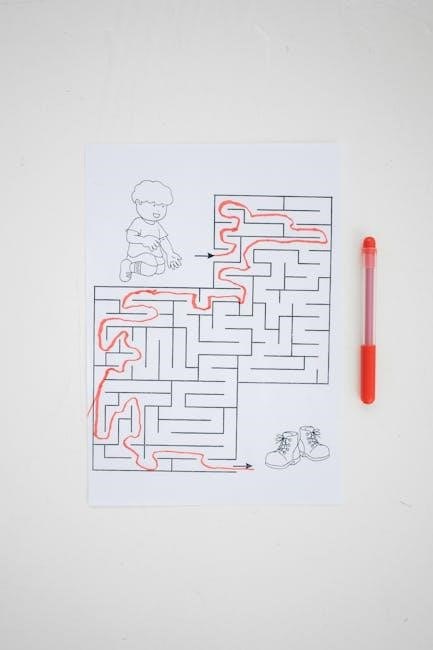Cognitive restructuring is a core CBT technique helping individuals identify and challenge negative thought patterns. It involves examining evidence for and against unhelpful thoughts, fostering balanced alternatives to improve emotional well-being through structured exercises.
1.1 What is Cognitive Restructuring?
Cognitive restructuring is a CBT technique that helps individuals identify and challenge negative, unhelpful thoughts by examining evidence for and against them. It involves replacing these thoughts with more balanced, constructive ones to improve emotional well-being. This process is often guided by structured worksheets, making it a practical tool for managing distressing emotions and behaviors effectively.
1.2 Importance of Cognitive Restructuring in CBT
Cognitive restructuring is a cornerstone of CBT, enabling individuals to identify and challenge negative thought patterns. By addressing distortions and fostering rational thinking, it helps reduce emotional distress and improve coping strategies. Its structured approach, often via worksheets, makes it a vital tool for addressing anxiety, depression, and other mental health challenges effectively.

Understanding Cognitive Restructuring Worksheets
Cognitive restructuring worksheets are practical tools in CBT, designed to help individuals identify and challenge negative thoughts and beliefs. They provide a structured format to guide users through the process of cognitive restructuring, making thoughts and emotions more manageable and promoting positive change.
2.1 What is a Cognitive Restructuring Worksheet?
A cognitive restructuring worksheet is a structured tool used in CBT to help individuals identify, challenge, and modify negative thought patterns. It typically includes sections for recording situations, emotions, automatic thoughts, evidence for and against these thoughts, and space for developing balanced, alternative perspectives. These worksheets guide users step-by-step through the cognitive restructuring process, promoting self-reflection and positive change.
2.2 Key Components of a Cognitive Restructuring Worksheet
A cognitive restructuring worksheet typically includes sections for identifying the triggering situation, listing emotions, documenting automatic thoughts, evaluating evidence for and against these thoughts, and developing alternative balanced perspectives. These components provide a structured format to guide individuals through the process of challenging and modifying unhelpful thought patterns effectively.

Steps to Use a Cognitive Restructuring Worksheet
Identify the triggering situation, recognize emotions, document automatic thoughts, challenge unhelpful beliefs, and develop balanced, constructive alternatives to modify negative thought patterns effectively.
3.1 Step 1: Identify the Triggering Situation
Begin by describing the specific situation that triggered your emotional response. Focus on objective facts rather than interpretations. This clarity helps pinpoint the source of distress, setting the stage for analyzing thoughts and emotions. Be concise and factual to avoid introducing bias early in the process;
3.2 Step 2: Recognize and Record Emotions
Next, identify and document the emotions you experienced during the triggering situation. Label them clearly, such as fear, anxiety, or sadness; Note the intensity of each emotion on a scale. This step helps connect your feelings to the situation and prepares you to examine underlying thoughts objectively.
3.3 Step 3: Become Aware of Automatic Thoughts
Identify the automatic thoughts that arose during the triggering situation. These are spontaneous, often negative reactions that occur without conscious analysis. Use the worksheet to capture these thoughts precisely as they occurred. This step helps you understand how these thoughts link to your emotions and behaviors, preparing you to evaluate their accuracy.
3.4 Step 4: Challenge and Question Negative Thoughts
Evaluate the validity of your automatic thoughts by asking probing questions. For example, “Is this thought based on evidence?” or “Is there another way to view this situation?” This step encourages critical examination, helping to uncover cognitive distortions and weaken unhelpful beliefs. It lays the groundwork for developing more balanced perspectives.
3.5 Step 5: Develop Alternative, Balanced Thoughts
Replace negative thoughts with more realistic and balanced ones. For example, instead of “I’ll never succeed,” try “I can learn from this experience.” Reframe perspectives to focus on constructive outcomes, reducing emotional intensity and fostering mental clarity. This step promotes lasting change by encouraging adaptive thinking patterns.
Common Cognitive Distortions to Address
Address cognitive distortions like all-or-nothing thinking, overgeneralization, catastrophizing, and disqualifying the positive. These distortions fuel negative emotions and hinder balanced thinking, requiring targeted intervention for effective restructuring.
4.1 All-or-Nothing Thinking
All-or-nothing thinking involves viewing situations in extremes, with no middle ground. For example, believing “I’m a total failure” after one mistake. Worksheets help identify and challenge this distortion, promoting balanced perspectives and reducing stark, unhelpful judgments that exacerbate emotional distress and hinder rational problem-solving.
4.2 Overgeneralization
Overgeneralization involves making sweeping conclusions based on a single event, such as believing “I’ll never succeed” after one failure. Worksheets help identify and challenge this distortion by encouraging individuals to examine evidence and develop more balanced, realistic perspectives, reducing anxiety and fostering more constructive problem-solving approaches.
4.3 Catastrophizing
Catastrophizing involves exaggerating the severity of a situation, assuming the worst possible outcome. Worksheets help individuals challenge this distortion by evaluating the likelihood of the feared outcome and exploring more balanced perspectives, reducing anxiety and fostering a more realistic understanding of potential consequences.
4.4 Disqualifying the Positive
Disqualifying the positive occurs when individuals dismiss or minimize positive experiences, undermining self-esteem. Worksheets guide users to acknowledge and reframe these dismissals, helping them recognize and value their achievements and positive emotions, fostering a more balanced and constructive self-view.

Benefits of Using Cognitive Restructuring Worksheets
Using cognitive restructuring worksheets helps reduce negative emotions, improve problem-solving skills, and enhance self-awareness, promoting emotional well-being and constructive thought patterns.
5.1 Reducing Negative Emotions
Cognitive restructuring worksheets effectively help individuals reduce negative emotions by identifying and challenging unhelpful thoughts. By examining evidence for and against these thoughts, users can develop balanced perspectives, leading to decreased feelings of sadness, anxiety, and frustration, and promoting emotional well-being through structured exercises.
5.2 Improving Problem-Solving Skills
Cognitive restructuring worksheets enhance problem-solving by teaching individuals to evaluate situations objectively. By identifying and challenging negative thoughts, users develop a clearer perspective, enabling them to generate practical solutions and make informed decisions, fostering effective coping strategies and improved outcomes in challenging scenarios.
5.3 Enhancing Self-Awareness
Cognitive restructuring worksheets promote self-awareness by guiding users to recognize and analyze their thoughts and emotions. This process helps individuals understand their thought patterns, identify cognitive distortions, and develop a deeper insight into their responses to situations, fostering personal growth and emotional intelligence through structured reflection and practice.

Examples of Cognitive Restructuring Worksheets
Common examples include Thought Record Worksheets, which track situations, emotions, and thoughts, and the 7-Column Thought Record for detailed analysis. These tools provide structured frameworks for identifying and challenging negative thought patterns, aiding in the development of more balanced perspectives.
6.1 Thought Record Worksheets
Thought Record Worksheets are essential tools in cognitive restructuring, designed to help users systematically analyze negative thought patterns. They typically include columns for situations, emotions, automatic thoughts, evidence for and against these thoughts, and balanced alternatives. By documenting these elements, individuals can identify cognitive distortions and develop more constructive ways of thinking, fostering emotional resilience and positive change.
6.2 7-Column Thought Record
The 7-Column Thought Record, inspired by “Mind Over Mood,” is a detailed worksheet for cognitive restructuring. It includes columns for Situation, Emotion, Automatic Thoughts, Evidence For, Evidence Against, Balanced Thoughts, and Action Plan. This structured format helps users systematically analyze and challenge negative thoughts, fostering evidence-based reflection and the development of more constructive thinking patterns to improve emotional regulation and decision-making.
6.3 Cognitive Restructuring Exercise Worksheet
The Cognitive Restructuring Exercise Worksheet is a practical tool designed to guide individuals through the process of identifying, challenging, and modifying negative thought patterns. It typically includes sections for describing the triggering situation, recognizing emotions, identifying automatic thoughts, questioning their validity, and developing balanced, constructive alternatives. This structured approach helps users gain insight and reduce negative emotional responses effectively.
Practical Applications of Cognitive Restructuring
Cognitive restructuring is a powerful CBT tool for managing anxiety, depression, and overcoming fears. It helps improve relationships and everyday problem-solving through structured exercises and thought analysis.
7.1 Managing Anxiety and Depression
Cognitive restructuring effectively addresses anxiety and depression by identifying and challenging negative thoughts. Worksheets guide individuals to examine evidence for their thoughts, fostering realistic perspectives and reducing emotional distress. Regular practice helps interrupt harmful thought patterns, promoting mental balance and emotional resilience through structured exercises tailored to address these conditions.
7.2 Overcoming Fears and Phobias
Cognitive restructuring helps individuals break down irrational fears and phobias by challenging unhelpful thoughts. Worksheets guide users to examine evidence for their fears, identify distortions, and develop realistic perspectives. This process reduces anxiety and builds confidence, enabling gradual exposure to feared situations and fostering coping strategies for long-term relief from phobic responses.
7.3 Improving Relationships
Cognitive restructuring enhances interpersonal connections by addressing negative thought patterns that strain relationships. Worksheets help individuals identify and challenge assumptions about others’ intentions, fostering empathy and open communication. By promoting balanced thinking, this technique encourages constructive conflict resolution, strengthens trust, and nurtures healthier, more supportive relationships over time;
Case Studies and Real-Life Examples
Real-life examples demonstrate how cognitive restructuring worksheets effectively address specific challenges, such as social anxiety or workplace stress, providing practical insights into applying techniques for personal growth;
8.1 Using Worksheets for Social Anxiety
Cognitive restructuring worksheets are highly effective for addressing social anxiety. They help individuals identify and challenge negative thoughts, such as fears of judgment or embarrassment, and replace them with balanced, realistic perspectives. By systematically examining evidence for and against these thoughts, individuals can reduce anxiety and improve social interactions, fostering confidence and emotional resilience over time.
8;2 Applying Cognitive Restructuring to Workplace Stress
Cognitive restructuring effectively addresses workplace stress by helping individuals identify and modify unhelpful thoughts about job demands or interactions. Worksheets guide users to examine evidence for and against negative beliefs, fostering rational perspectives. This process reduces emotional reactivity, enhances problem-solving, and promotes a more constructive approach to workplace challenges, improving overall job satisfaction and well-being.
Variations of Cognitive Restructuring Worksheets
Cognitive restructuring worksheets vary to suit different needs, from basic versions for beginners to advanced templates for complex issues, ensuring tailored approaches for effective thought transformation.
9.1 Basic Worksheets for Beginners
Basic cognitive restructuring worksheets are designed for newcomers, offering simple, step-by-step guides to identify and challenge negative thoughts. These tools typically include sections for listing emotions, triggers, and alternative perspectives, making them accessible and easy to use for individuals just starting their CBT journey.
9.2 Advanced Worksheets for Complex Issues
Advanced cognitive restructuring worksheets tackle intricate emotional challenges, offering detailed frameworks for deeper analysis. These include multi-step exercises, nuanced thought exploration, and evidence-based reflection, ideal for addressing chronic issues or deeply ingrained thought patterns, helping users develop sophisticated coping strategies and insights.

Cultural and Individual Considerations
Cognitive restructuring must account for cultural differences and individual experiences, ensuring worksheets are adaptable to diverse backgrounds and personal circumstances for effective, culturally sensitive therapy outcomes.
10.1 Adapting Worksheets for Different Populations
Cognitive restructuring worksheets can be tailored to meet the needs of diverse populations by incorporating culturally sensitive language and examples. This ensures the exercises are relatable and effective for individuals from various backgrounds, promoting better engagement and outcomes in therapy.
10.2 Ensuring Cultural Sensitivity in Cognitive Restructuring
Cultural sensitivity is crucial in cognitive restructuring to respect diverse values and beliefs. Worksheets should be adapted to reflect individual experiences, ensuring that examples and language resonate with the user’s background, enhancing the therapy’s effectiveness and fostering a trusting therapeutic relationship.
Evidence Supporting Cognitive Restructuring
Research highlights cognitive restructuring’s effectiveness in reducing negative emotions and improving mental health outcomes. Studies by Beck and others validate its evidence-based approach, demonstrating long-term benefits for individuals.
11.1 Research on the Effectiveness of Cognitive Restructuring
Research demonstrates cognitive restructuring’s effectiveness in reducing negative emotions and improving mental health outcomes. Studies by Beck and others show significant symptom reduction in anxiety and depression. The structured approach of worksheets enhances cognitive-behavioral changes, making it a widely accepted, evidence-based intervention for long-term emotional well-being and resilience.
11.2 Studies Showing Long-Term Benefits
Long-term benefits of cognitive restructuring are evident in reduced symptoms of anxiety and depression. Research by Beck and others highlights sustained improvements in emotional regulation and thought patterns. Consistent practice with worksheets enhances resilience, promoting lasting positive changes in mental health and well-being over time.

Resources for Cognitive Restructuring Worksheets
Recommended books include Beck’s Cognitive Behavior Therapy and Mind Over Mood. Downloadable PDF worksheets, such as the 7-Column Thought Record, are widely available online for practice. Additionally, guides and handouts from the National Institute for Health offer comprehensive tools for cognitive restructuring exercises.
12.1 Recommended Books and Guides
Recommended books include Cognitive Behavior Therapy: Basics and Beyond by J.S. Beck and Mind Over Mood. These guides provide detailed frameworks and practical examples for cognitive restructuring. Additional resources include downloadable PDF handouts from the National Institute for Health, offering evidence-based tools and exercises for effective practice.
12.2 Free Downloadable PDF Worksheets
Free downloadable PDF worksheets, such as the Thought Record and 7-Column Thought Record, are widely available online. These tools, often sourced from books like Mind Over Mood and Cognitive Behavior Therapy: Basics and Beyond, provide structured exercises for identifying and challenging negative thoughts. Many websites, including those from the National Institute for Health, offer these resources for easy access and practice.

Tips for Effective Use of Worksheets
Practice consistently, take time to complete each section thoroughly, and consider working with a therapist or mentor for guidance and support in mastering cognitive restructuring techniques effectively.
13.1 Consistency in Practice
Consistency is key to mastering cognitive restructuring. Regular practice helps reinforce new thought patterns, reduces negative emotions, and fosters long-term behavior change. Dedicate time daily to complete worksheets, ensuring gradual progress and sustained improvement in emotional resilience and mental clarity over time through persistent effort and commitment to the process.
13.2 Working with a Therapist or Mentor
Collaborating with a therapist or mentor enhances the effectiveness of cognitive restructuring. They provide personalized guidance, feedback, and support, helping you navigate complex emotions and thoughts. Their expertise ensures accurate identification of cognitive distortions and development of realistic alternative thoughts, accelerating progress and reinforcing skills learned through worksheets and exercises in a structured environment.
Cognitive restructuring worksheets are powerful tools for managing emotions and thoughts. As research evolves, innovative tools and techniques will emerge, enhancing mental health advancements and therapeutic practices globally.
14.1 The Role of Cognitive Restructuring in Modern Therapy
Cognitive restructuring remains a cornerstone of CBT, offering an evidence-based approach to addressing mental health issues. Its versatility in treating anxiety, depression, and workplace stress underscores its enduring relevance in modern therapeutic practices, supported by research and clinical recommendations.
14.2 Future Developments in Cognitive Restructuring Tools
Future advancements in cognitive restructuring tools may include interactive digital platforms, AI-driven personalized exercises, and enhanced accessibility through mobile apps. These innovations aim to make cognitive restructuring more engaging and effective, ensuring wider reach and improved mental health outcomes for diverse populations.
